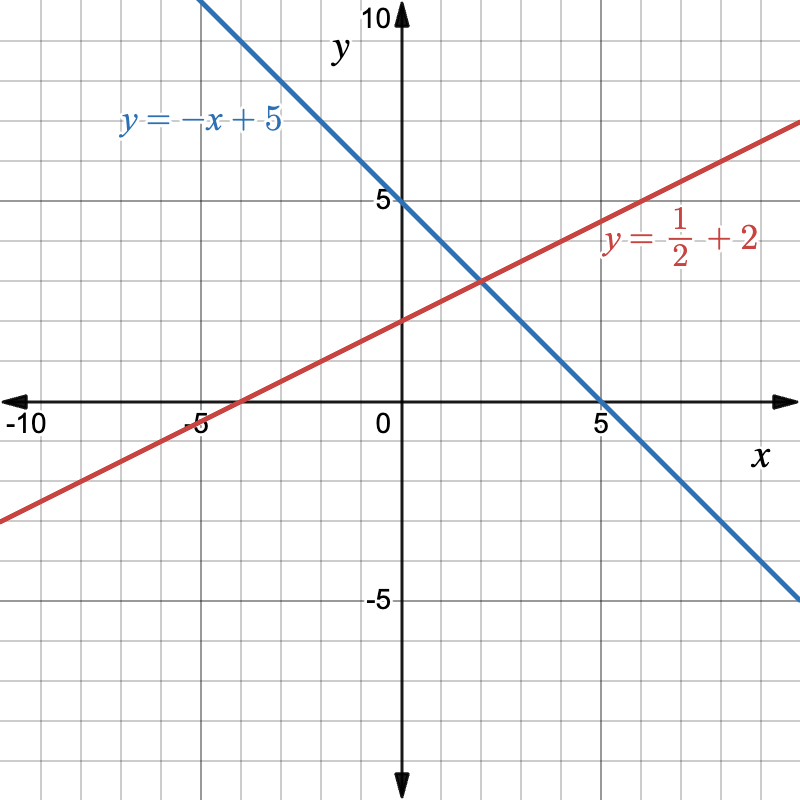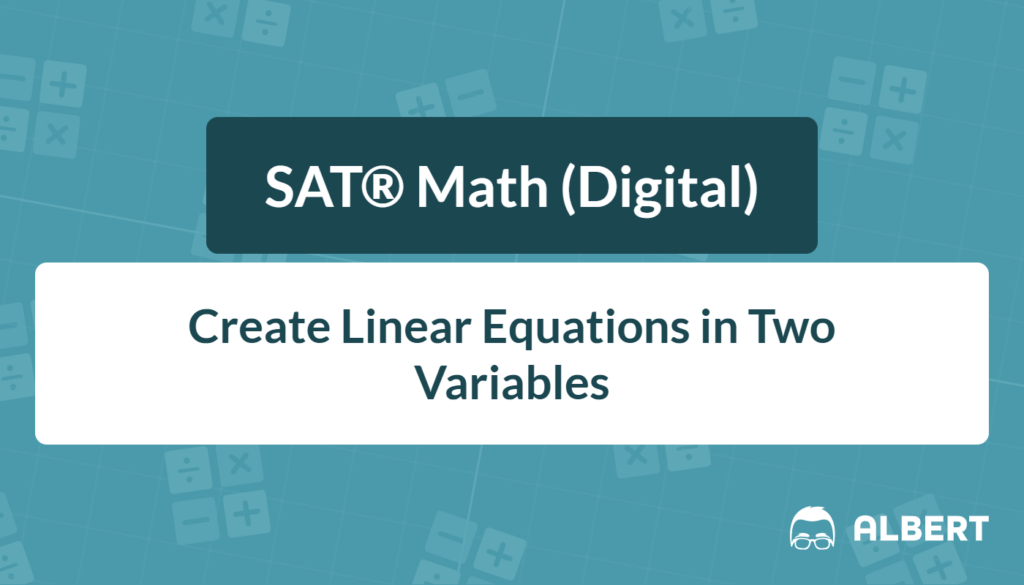What We Review
Why Linear Equations Matter on the SAT®
Linear relationships appear in nearly \boldsymbol{25\%} of SAT® Math questions. Therefore, a solid grip on them, including two variable equations, can raise a score quickly. Each question is really a small puzzle: turn an everyday situation into a solvable rule, then read the rule for answers. This guide builds those practical skills step by step.
What Is a Linear Equation in Two Variables?
A linear equation in two variables is a rule that links two quantities (usually x and y) in a straight-line pattern.
Three standard forms dominate the SAT®:
- Slope–intercept form: y = mx + b
- Standard form: Ax + By = C
- Point–slope form: y - y_1 = m(x - x_1)
Because the equation is first-degree in both variables, its graph is always a straight line.

Slope–Intercept Form: y = mx + b
Breaking Down the Parts
- Slope (m) – change in y for every 1-unit change in x.
- y-intercept (b) – starting value when x = 0.
Worked Example
A babysitter charges a \$12 travel fee plus \$9 per hour. Write an equation for total cost (C) after h hours, then find the cost of 4 hours.
Step 1: Define the variables
Let h represent the number of hours the babysitter works, and let C represent the total cost.
Step 2: Identify the rate (slope)
The babysitter charges \$9 per hour, so the rate is 9.
Step 3: Identify the starting value (intercept)
There is a one-time travel fee of \$12, which is the initial fixed cost.
Step 4: Write the equation
Using the slope-intercept form C = 9h + 12, where 9 is the rate per hour and \$12 is the fixed travel fee.
Step 5: Substitute h = 4 to find the cost for 4 hours
C = 9(4) + 12 = 36 + 12 = 48
The total cost for 4 hours is \$48.
Quick Tip! When a question shows numbers like Ax + By = C, rewrite to y = mx + b to read slope and intercept instantly.
Creating Two-Variable Equations From Word Problems
Four-Step Strategy
- Identify the two quantities.
- Choose variables.
- Locate slope (rate) and intercept (starting amount).
- Write and check the equation.
Real-World Example
A phone plan costs \$20 per month plus \$3 for each gigabyte of data used.
Step 1: Identify the quantities
The two quantities involved are data usage in gigabytes (g) and total monthly cost (C).
Step 2: Define the variables
Let g represent the number of gigabytes used and C represent the total monthly cost.
Step 3: Determine the rate and starting value
The rate (slope) is \$3 per gigabyte, and the starting value (intercept) is the fixed monthly fee of \$20.
Step 4: Write the equation
Using slope-intercept form, the equation is C = 3g + 20.
Step 5: Substitute g = 7 to find the monthly cost
C = 3(7) + 20 = 21 + 20 = 41
If 7 GB are used, the total monthly bill is \$41.
Interpreting Parts of a Two-Variable Equation in Context
Once a model is set, each number tells a story.
The equation 4x + 2y = 40 models a snack budget where x represents the number of pretzels (\$4 each) and y represents the number of drinks (\$2 each).
- Coefficient 4 → cost per pretzel.
- Coefficient 2 → cost per drink.
- Constant 40 → total money available.
Seeing the structure can help. Let’s divide both sides by 2 → 2x + y = 20
Now we can see that the cost per drink is \$1, which may speed mental math.
Multiple Representations of Two-Variable Equations
The SAT® often toggles among three representations of two-variable equations: tables, graphs, and equations.
Example: y = -2x + 6
Here are some tips to change from one representation to another.
- Equation → Table
- Pick x-values (–1, 0, 1, 2). Compute y.
- Table → Graph
- Plot the points found above.
- Graph → Equation
- \text{Slope}=\frac{\text{Rise}}{\text{Run}}=–2
- y-intercept is 6 → equation must be y = -2x + 6.
Finding Missing Values in Two-Variable Equations
If one value in a two-variable equation is known, we can substitute the known variable and solve for the other.
Example: Given 5x - 3y = 12, find y when x = 3.
| Step | Reason |
|---|---|
| 5(3) - 3y = 12 | Substitute x=3 into the equation |
| 15 - 3y = 12 | Simplify |
| 15 \color{red}{-15} -3y = 12 \color{red}{-15} | Subtract 15 from both sides |
| -3y = -3 | Simplify |
| \dfrac{-3y}{\color{red}{-3}} = \dfrac{-3}{\color{red}{-3}} | Divide both sides by -3 |
| y = 1 | Final answer ✅ |
Therefore, the ordered pair is (3, 1).
Writing a Two-Variable Equation When You Have…
Two Points
Given (–2, 5) and (4, –1).
- Slope: m = \dfrac{-1 - 5}{4 - (-2)} = \dfrac{-6}{6} = -1
- Use one point in point-slope: y - 5 = -1(x + 2)
- Simplify → y = -x + 3
One Point + Slope
Point (1, 8), slope 3.
Write the equation in Point-slope form and convert to slope-intercept form, if needed.
y - 8 = 3(x - 1) → y = 3x + 5One Point + Parallel Line
Through (–3, 4), parallel to 2x - y = 7.
- Parallel → same slope. First, solve the original equation for y:
- -y = -2x + 7 \Rightarrow y = 2x - 7; slope = 2.
- Now: y - 4 = 2(x + 3) → y = 2x + 10
One Point + Perpendicular Line
Through (2, 5), perpendicular to y = -\frac{1}{2}x + 6.
- Perpendicular slope → negative reciprocal of –\frac{1}{2} = 2.
- Equation: y - 5 = 2(x - 2) → y = 2x + 1
Common Pitfalls and Time-Saving SAT® Tips
- Sign slips with negative slopes—slow down on subtraction.
- Intercept mix-ups—remember the x-intercept occurs when y = 0 and the y-intercept occurs when x=0
- Calculator table trick—On graphing calculators, “TABLE” displays (x, y) quickly; use it to hunt integer solutions.
- 30-second elimination—If only one answer choice has the correct y-intercept, pick it without further work.
Two-Variable Equations Quick Reference Chart
| Term | Student-Friendly Definition |
| Slope (m) | How much y changes for a 1-unit change in x |
| y-intercept (b) | Point where the line crosses the y-axis (x = 0) |
| Standard Form | Ax + By = C where A, B, C are integers |
| Parallel Lines | Lines with equal slopes, never meeting |
| Perpendicular Lines | Lines whose slopes multiply to –1 |
| Rate of Change | Another name for slope in context |
| Constant Term | The standalone number (e.g., b) |
| Solution Point | Any (x, y) making the equation true |
| x-Intercept | Point where y = 0 |
| Linear Equation in Two Variables | First-degree equation relating x and y |
Two-Variable Equation Practice Problems
- A gym charges \$15 sign-up plus \$25 per month.
- a) Write an equation for total cost (C) after m months.
- b) How much after 6 months?
- Find the equation of the line through (–4, 2) and (2, –3).
- A line has the equation 3x + 2y = 18.
- a) What is its slope?
- b) What is the y-intercept?
- Write an equation of the line perpendicular to y = 4x - 9 that passes through (0, –2).
Answers
- a) C = 25m + 15; b) \$165
- y = -\tfrac{5}{6}x - \tfrac{1}{3}
- a) slope = –1.5; b) y-intercept = 9
- y = -\frac{1}{4}x - 2
Next Steps for Mastery
Mastery grows with repeated, spaced practice. Therefore, revisit these steps while studying systems of equations and linear inequalities; the ideas overlap. Finally, timed quizzes and official SAT® practice tests will lock in speed and confidence. Keep building—each new line written is a point earned on test day.
Sharpen Your Skills for SAT® Math (Digital)
Are you preparing for the SAT® Math (Digital) test? We’ve got you covered! Try our review articles designed to help you confidently tackle real-world SAT® Math (Digital) problems. You’ll find everything you need to succeed, from quick tips to detailed strategies. Start exploring now!
Need help preparing for your SAT® Math (Digital) exam?
Albert has hundreds of SAT® Math (Digital) practice questions, free response, and full-length practice tests to try out.









